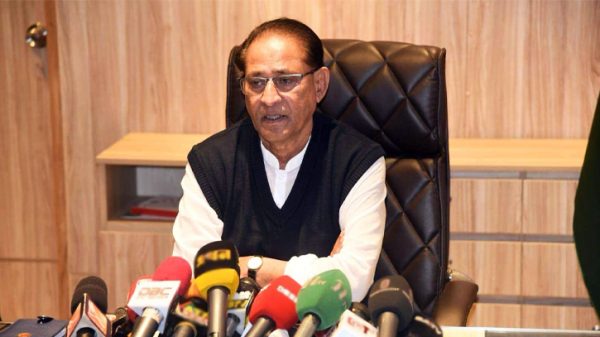Staff Reporter:
The Commission of Inquiry on Enforced Disappearance has identified over eight secret detention centers of fallen Awami League era operated by different security agencies in Dhaka and Chatto-gram.
“To date, we (commission) have identified more than eight secret detention facilities operated by agencies such as (Directorate General of Forces Intelligence) DGFI, (Rapid Action Battalion) RAB, and (Counter Terrorism and Transnational Crime) CTTC, where victims were held across the coun-try,” the commission report said.
The five-member commission led by retired justice Mainul Islam Chowdhury handed over the re-port titled “Unfolding The Truth” to Chief Adviser Professor Muhammad Yunus at the state guest house Jamuna here on Saturday.
The commission chairman said they had found the prima facie involvement of deposed prime min-ister Sheikh Hasina and some high-ranking officials of security forces and her government includ-ing her defense adviser Major General (retd) Tarique Ahmed Siddique in the enforced disappear-ances.
It also found the involvement of former director general of the National Telecommunication Moni-toring Centre, and sacked Major General Ziaul Ahsan, senior police officers Monirul Islam and Md. Harun-Or-Rashid, with several incidents of enforced disappearance,
The commission in its report said Several secret detention centres were found still intact, while others had been destroyed, .
It said it conducted visits to twelve offices of various security forces in Dhaka and Chattogram as the purpose of these visits was to inspect interrogation rooms, detention facilities, and equipment; gather information and testimony; and meet with senior officials from law enforcement and securi-ty forces.
To safeguard the integrity of the inquiry, the details of these facilities will be disclosed in a future report, it said.
“For now, we can confirm that we visited the following offices: Directorate General of Forces Intel-ligence; Counter Terrorism and Transnational Crime; Detective Branch Headquarters, Dhaka Met-ropolitan Police; Detective Branch, Chittagong Metropolitan Police; Rapid Action Battalion units 1, 2, 4, 7, and 11, including RAB 2, CPC 3; RAB Forces Headquarters; Chittagong Central Jail; and the National Security Intelligence, Chittagong Division,” the report added.
The accounts of torture that have been documented are both profoundly brutal and disturbingly methodical and a notable distinction has emerged between the premises under the management of military officers and those overseen by civil forces, such as the police, it said.
In facilities managed by civil forces, such as DB and CTTC, torture was carried out in a manner that integrated it into the daily operations of these offices, the report said.
“Our findings indicate that although specialized torture equipment was used, the acts of torture were conducted routinely within the same space occupied by the security personnel,” it said.
“Detainees have reported witnessing officers calmly working at their desks or computers-screams of agony notwithstanding-within close proximity to the areas where torture was being perpetrated, suggesting a disturbing normalization of such practices at these offices”, it said.
“Conversely, the premises controlled by military commanders, such as those managed by RAB and DGFI, exhibited a more specialized infrastructure for torture. These facilities were often equipped with soundproofed chambers and specialized instruments, including mechanized ones, designed explicitly for inflicting physical and psychological harm,” the report said.
The commission said they are withholding detailed descriptions of these facilities to safeguard the integrity of ongoing inquiry as it will provide a comprehensive account in the commission’s final report.
“At this stage, we present two examples to illustrate the nature and severity of the torture practices employed,” it said.
In one instance in 2010, a young man was abducted by RAB from Dhanmondi. He reported that he was taken to a room where his lips were immediately sewn without the use of any anesthesia, it said.
He described the procedure as being akin to stitching cowhide, underscoring the utter dehumaniza-tion inflicted upon him, it added.
In a separate incident eight years later, it said that a middle-aged man recounted that his genitals and ears were electrocuted and this torture also took place at a RAB facility.
The consistency in torture practices, despite the significant temporal and geographical separation between these cases, strongly suggests that such practices were not only systemic but also institu-tionalized across these forces, the commission report said.
These findings highlight the pervasive and calculated nature of torture within the entities and stress the urgent need to address the structural and cultural factors that have allowed these practic-es to persist, it said.
The commission said they already recorded a total of 1,676 complaints of enforced disappearances, while 758 complaints have already been scrutinized. It estimates the number of enforced disap-pearances in the country would cross 3,500.
It also recommended disbanding the Rapid Action Battalion (RAB).
While submitting the report, the commission chairman said they had found a “systematic design” so that the incidence of enforced disappearances remains undetected.
He said that they would deliver another interim report in March and would require at least another year to complete the scrutiny of all allegations they had received.









































